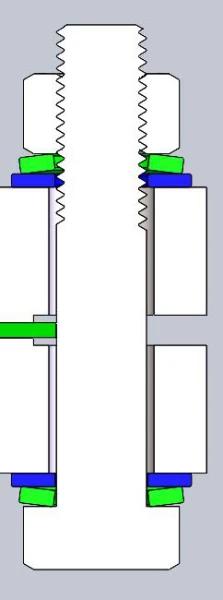Using Flat Washers with Belleville Washers

Standard joint with flat washers (blue)
& Belleville washers (green)
& Belleville washers (green)
Let's start by going over the basic functions of both fastener elements:
- A Belleville washer functions as a spring, adding elasticity under load. This elasticity acts similarly to bolt stretch, maintaining preload in the event of relaxation or joint expansion.
- A flat washer is used to spread out force of a bolt or nut onto a larger area of the joint surface. This protects the surfaces of the joint from damage and prevents embedment (i.e. the bolt head digs into joint surface). Functionally, embedment of a bolt or nut decreases the load of the joint and can be a cause of loosening.
Why they work well together
As they do not serve the same function, a Belleville washer and a flat washer can work in tandem to improve the joint. A Belleville works best when it has a flat and smooth bearing surface. This is because the contact surface, (the top inside corner and the bottom outside corner), slides/rolls as the washer deforms to flat. The less friction created by this motion, the better. Without a flat washer, the bottom bearing surface is up against the joint surface. The addition of the flat washer provides a better bearing surface, as well as distributing the load. A flat washer is not required on top of the Belleville as the bolt or nut usually provide an adequate bearing surface to limit friction.When a Belleville washer does not require a flat washer
Given the right set of circumstances, a Belleville washer will work just fine without a flat washer. It all depends on the joint surface. As stated above, a Belleville washer does not distribute the load nearly as well as a flat washer. If the joint surface is relatively soft or is susceptible to embedment, the washer may dig in. If the surface is uneven or rough, the increase in friction may cause a lower load. However, if the joint surface is hard, even and smooth, a Belleville may be used without a flat washer with minimal change in joint performance.
Selecting the right flat washer
There are three factors to consider when selecting the right flat washer.1. It is important to make sure that the Belleville, bolt, and flat washer used are of a similar material family. Stainless steel should be used with stainless steel, and zinc-plated carbon with zinc-plated carbon. This will help to prevent the problems caused by galvanic corrosion and differential thermal expansion.
2. It is important that the flat washer OD is large enough to accommodate the Belleville's OD. If the washer OD is too small so that the Belleville overhangs, then the loading characteristics will be altered, limiting the defleciton available for preload retention.
3. The thickness of the flat washer should be at least one-third the thickness of the Belleville washer. This will ensure that the washer itself does not deform under the intended load. This assumes that the flat washer is fully supported by the joint. If the flat washer is not fully supported, then a thicker washer may be warranted.
If your application requires both load distribution and the spring action of a Belleville washer, using them together can be effective. Always consider the specific requirements of your assembly to determine if this combination is suitable.
Solon Belleville Springs & washers advantages
Installing Solon Belleville Springs & Washers to the fastening system ensures a proven and reliable connection. Solon Belleville Springs & Washers increase the elasticity of the bolting system by maintaining consistent, and sufficient bolt preload— providing improved bolted joint reliability, preventing unplanned or costly downtime, and protecting your assets.Solon Manufacturing, an industry leader on engineered solutions for critical applications, can help from design through aftermarket to ensure bolts have the correct mating parts that will effectively support any applications. Often there are standard options already available, though a custom Belleville washer can be engineered around specifications.
Solon Belleville Springs & Washers are used in a variety of applications and industries to maintain bolt preload on bolted joints and connections. Solon Belleville Springs & Washers minimize the effects of differential thermal expansion, vibration, embedment relaxation, bolt yield/creep, and thermal cycling.
Additional information such as calculator tools, videos, case studies and technical white papers can be found in our resource library.
Learn more about the use of Belleville springs & washers in bolting applications:
Application: General Purpose BoltingApplication: Commercial Bolting Applications
Calculator: Bolt Stretch Calculator
Calculator: Infinite Bolt Life Fatigue Calculator
White Paper: Why Increased Elasticity Leads to Reduced Self-Loosening
Video: Solon Belleville Spring Washers
Product Selection Tools: Application Specific Calculators
Contact Us



